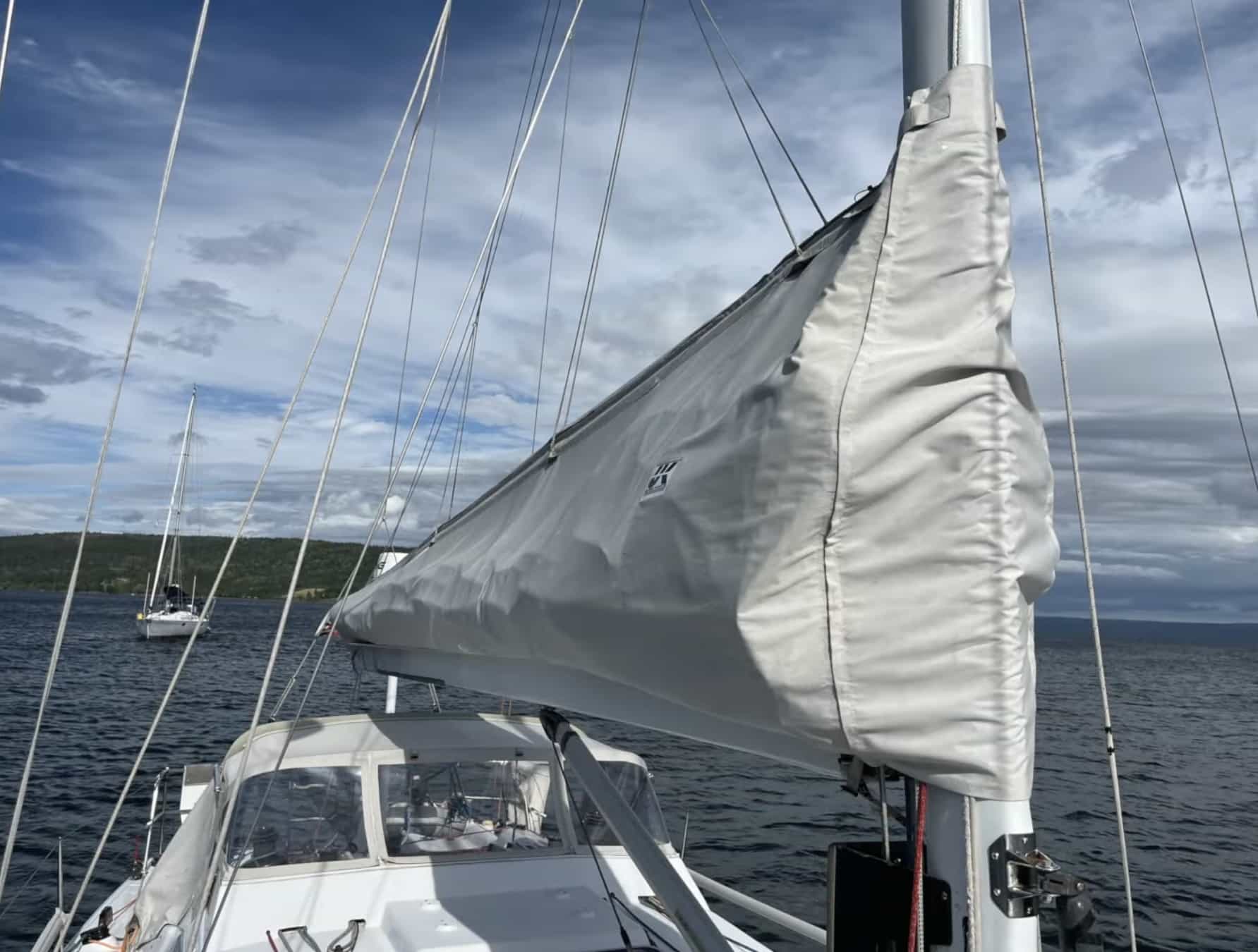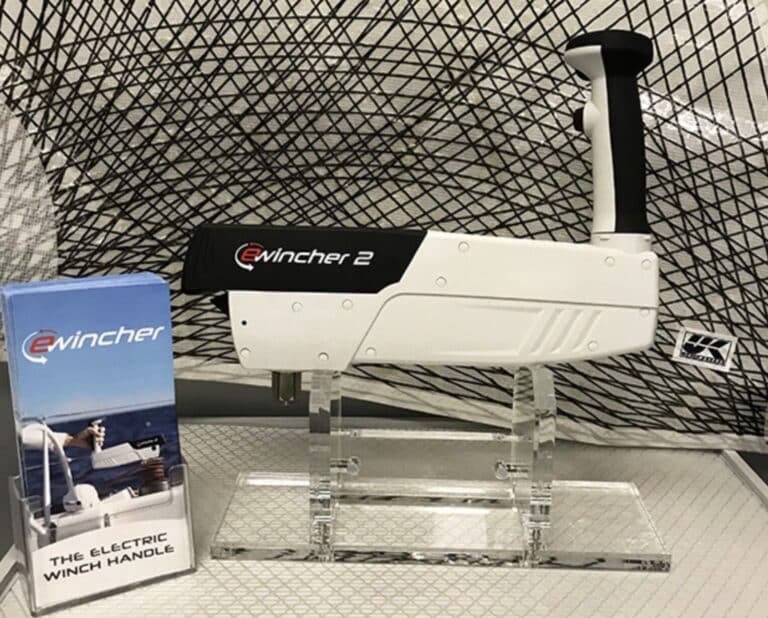Besides the auto pilot, the one piece of equipment that makes shorthanded sailing easier and more enjoyable is my Lazy Cradle. Controlling a mainsail when you lower it can be a challenge even with a full crew, but when shorthanded, it can be a bigger problem. However, with my Lazy Cradle, that problem goes away. A Lazy Cradle is a combination of a sail cover and lazy jacks, where the sail cover is attached to the top of the boom and goes under the mainsail while the upper edges are raised in place with the boat’s lazy jacks. The lazy jacks guide the sail down into the cover. Click here for more information.
On top of the cover, there are full-length round-battens on each side of the zipper. The battens help hold the cover open when the sail is lowered. The battens give the cover it’s clean shape, and the lazy jacks dead-end around the battens to transmit the supporting load across the whole length of the cover.
Dropping the Mainsail in the Lazy Cradle
With the Lazy Cradle I can literally drop my mainsail into the cover faster than a furling main can be rolled into the mast or boom. I just release the halyard and gravity does the rest. Coming into a harbor is no problem; just drop the sail and it is out of the way without the need to flake or furl. With the sail contained in the cover, you can concentrate on the channel and other boat traffic with out being blinded by draping sailcloth. Later, when I’m at anchor, I can zip the cover over the sail and then zip the front piece that goes around the mast so that the sail is totally protected from the sun’s harmful UV rays.
Having the Lazy Cradle is the only way I can tame my monster mainsail when sailing single- or short-handed. My main is 56.5feet on the luff and 20 feet on the boom, which makes it 565 sq/ft. The sail weighs 112 pounds and is made of Hydranet Radial, which is very stiff. I have such a heavy sail because I am doing a lot of offshore passagemaking. The weight and the stiffness of the cloth makes it hard to manually flake. Those factors led me to install a Lazy Cradle before taking off for my cruising adventures. The other reason for the Lazy Cradle is that standard sail covers are hard to put on when a boat has lazy jacks.
I have a few tips on how to make the system work like greased lightning. First, my mainsail has ball-bearing slider cars, which allows gravity to do the work. A Tides Marine Strong Track would work well, too. Second, I replaced the lazy jack lines that came with my Lazy Cradle to 3/16” Dyneema line because Dyneema is much stronger, lighter and thinner than the standard polyester line. The Dyneema lazy jacks are also less windage when sailing.
Proper adjustment of the lazy jack lines is critical. Under sail they have to be loosened to prevent them from distorting the sail’s shape. Before dropping they have to be tightened so that the cover can be zipped easily. If the lazy jacks are loose, the back of the cover splays open making it hard to start the zipper. Also, if they are loose, the cover will be too low to zip over the headboard of the mainsail. In order to reset them properly, make sure to have a mark when they are properly tensioned.
Another tip is to get the recirculating zipper line outside of the cover before dropping the sail. If you forget to do this, the sail will fall on top of the line and you have to free it before the cover can be zipped. Not only is the sail on top of it, but somehow, the line aways gets tangled with the buckles of the integral sail ties and straps used for securing the cover to the side of the boom when sailing (an option when underway).
It is recommended to roll and secure the cover to the boom on a long ocean passages or when you are racing. Having the cover rolled next to the boom is more aerodynamic and reduces wear from the cover bouncing around for hours at a time. However, when sailing shorter passages, I leave the cover up.
Also, when putting in a reef, make sure your Lazy Cradle is clear before tightening the reef outhaul. One time at sea, when we reefed in a hurry, we didn’t notice that the reef line had wrapped around the aft end of the Cradle. While trapped, the long batten ripped through the end of its pocket. Luckily, we noticed it before the batten fell overboard.
For most of the sailing I do, I leave the cover up so that I can drop the sail at a moment’s notice. For instance, if the wind dies and the sail starts slatting, I can drop the sail by myself without having to get help from the off-watch crew. The two things I have to remember to do before dropping the sail is to tighten the lazy jacks and get the zipper line out of the cover. The Lazy Cradle is absolutely the easiest way to drop and cover a mainsail for shorthanded sailors.
The Lazy Cradle is not only a cruising convenience, it is a piece of safety equipment as well. I have been an instructor at the Storm Trysail Club’s hands-on Safety at Sea Seminars in New York for nearly two decades. This year SOULMATES was used to teach man overboard recovery. STC teaches that it is extremely important to recover an MOB on the first try, and the best way to do it is to drop your sails quickly and return to the MOB under power. With the Lazy Cradle, not only can I drop the main fast, but it is contained and out of the way. On boats without a Lazy Cradle, the STC teaches to drop the sail on the side of the boat opposite of the LifeSling so that the sail is out of the way. You can see how much safer it is to have the sail contained in the cover instead of just pushed to the side. For more on the MOB recovery, click here.





